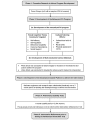A Culturally Relevant Smartphone-Delivered Physical Activity Intervention for African American Women: Development and Initial Usability Tests of Smart Walk
- PMID: 32130198
- PMCID: PMC7076402
- DOI: 10.2196/15346
A Culturally Relevant Smartphone-Delivered Physical Activity Intervention for African American Women: Development and Initial Usability Tests of Smart Walk
Abstract
Background: Smart Walk is a culturally relevant, social cognitive theory-based, smartphone-delivered intervention designed to increase physical activity (PA) and reduce cardiometabolic disease risk among African American (AA) women.
Objective: This study aimed to describe the development and initial usability testing results of Smart Walk.
Methods: Smart Walk was developed in 5 phases. Phases 1 to 3 focused on initial intervention development, phase 4 involved usability testing, and phase 5 included intervention refinement based on usability testing results. In phase 1, a series of 9 focus groups with 25 AA women (mean age 38.5 years, SD 7.8; mean BMI 39.4 kg/m2, SD 7.3) was used to identify cultural factors associated with PA and ascertain how constructs of social cognitive theory can be leveraged in the design of a PA intervention. Phase 2 included the analysis of phase 1 qualitative data and development of the structured PA intervention. Phase 3 focused on the technical development of the smartphone app used to deliver the intervention. Phase 4 consisted of a 1-month usability trial of Smart Walk (n=12 women; mean age 35.0 years, SD 8.5; mean BMI 40 kg/m2, SD 5.0). Phase 5 included refinement of the intervention based on the usability trial results.
Results: The 5-phase process resulted in the development of the Smart Walk smartphone-delivered PA intervention. This PA intervention was designed to target social cognitive theory constructs of behavioral capability, outcome expectations, social support, self-efficacy, and self-regulation and address deep structure sociocultural characteristics of collectivism, racial pride, and body appearance preferences of AA women. Key features of the smartphone app included (1) personal profile pages, (2) multimedia PA promotion modules (ie, electronic text and videos), (3) discussion boards, and (4) a PA self-monitoring tool. Participants also received 3 PA promotion text messages each week.
Conclusions: The development process of Smart Walk was designed to maximize the usability, cultural relevance, and impact of the smartphone-delivered PA intervention.
Keywords: African-American; eHealth; exercise; heart diseases; mHealth; minority health; primary prevention.
©Rodney P P Joseph, Colleen Keller, Sonia Vega-López, Marc A Adams, Rebekah English, Kevin Hollingshead, Steven P Hooker, Michael Todd, Glenn A Gaesser, Barbara E Ainsworth. Originally published in JMIR mHealth and uHealth (http://mhealth.jmir.org), 02.03.2020.
Conflict of interest statement
Conflicts of Interest: None declared.
Figures
References
-
- Benjamin EJ, Blaha MJ, Chiuve SE, Cushman M, Das SR, Deo R, de Ferranti SD, Floyd J, Fornage M, Gillespie C, Isasi CR, Jiménez MC, Jordan LC, Judd SE, Lackland D, Lichtman JH, Lisabeth L, Liu S, Longenecker CT, Mackey RH, Matsushita K, Mozaffarian D, Mussolino ME, Nasir K, Neumar RW, Palaniappan L, Pandey DK, Thiagarajan RR, Reeves MJ, Ritchey M, Rodriguez CJ, Roth GA, Rosamond WD, Sasson C, Towfighi A, Tsao CW, Turner MB, Virani SS, Voeks JH, Willey JZ, Wilkins JT, Wu JH, Alger HM, Wong SS, Muntner P, American Heart Association Statistics CommitteeStroke Statistics Subcommittee Heart disease and stroke statistics-2017 update: a report from the American Heart Association. Circulation. 2017 Mar 07;135(10):e146–e603. doi: 10.1161/CIR.0000000000000485. http://europepmc.org/abstract/MED/28122885 - DOI - PMC - PubMed
-
- Colberg SR, Sigal RJ, Fernhall B, Regensteiner JG, Blissmer BJ, Rubin RR, Chasan-Taber L, Albright AL, American Heart Association Statistics Committee and Stroke Statistics Subcommittee Exercise and type 2 diabetes: the American College of Sports Medicine and the American Diabetes Association: joint position statement executive summary. Diabetes Care. 2010 Dec;33(12):2692–6. doi: 10.2337/dc10-1548. http://europepmc.org/abstract/MED/21115771 - DOI - PMC - PubMed
-
- 2008 physical activity guidelines for Americans. Hyattsville, MD: US Department of Health and Human Services; 2008.
-
- Williams WM, Yore MM, Whitt-Glover MC. Estimating physical activity trends among blacks in the United States through examination of four national surveys. AIMS Public Health. 2018;5(2):144–157. doi: 10.3934/publichealth.2018.2.144. http://europepmc.org/abstract/MED/30094277 - DOI - PMC - PubMed
Publication types
MeSH terms
Grants and funding
LinkOut - more resources
Full Text Sources


